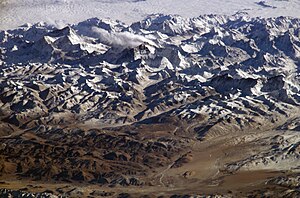Himalayas




TheHimalayasare amountain rangein SouthAsia.
The west end of the mountain range is inPakistan.They run throughJammu and Kashmir,Himachal Pradesh,Uttarakhand,SikkimandArunachal Pradeshstates inIndia,Nepal,andBhutan.The east end is in the south of Tibet. They are divided into 3 parts: Himadri, Himachal and Shiwaliks.
The 15 highest mountains in the world are in the Himalayas. The main ones areMount Everest,Annapurna,andNanga Parbat.Mount Everest is the highest mountain on Earth, at 8,849 meters. Of the fifteen highest mountain peaks in the World, nine are in the Nepali Himalayas.
The word "Himalaya" meansHouse of SnowinSanskrit,an oldIndianlanguage. The Himalayas are so high that they kept the Indian andChinesepeople separate from each other most of the time. India is apeninsulathat is cut off from the rest of Asia by the mountains. It is often called theIndian subcontinentbecause it is larger and more isolated than other peninsulas.
North of the Himalayas is theTibetan Plateau.It is called "the roof of the world". However, the Tibetan Plateau is very dry both because of its high elevation and the mountains acting to make a giganticrain shadow.The rain, coming from the south, falls on the south side of the mountains. This has greatly influenced the climate of the Indian subcontinent. Not only do the mountains block the extremely cold winter winds blowing fromCentral Asiafrom entering the Subcontinent, they also forces the Bay of BengalMonsoonbranch to shed its moisture along NE and Northern Indian States, Bhutan, Nepal and Bangladesh.
Formation of the Himalayas
[change|change source]Geologically, the origin of the Himalayas is the collision of the Indiantectonic platewith theEurasian plate.TheIndian platetravels northward at 15 cm per year, and joined the Eurasian continent about 40-50 million years ago. The formation of the Himalayas resulted in the lighter rock of the seabeds of that time being lifted up into mountains. An often-cited fact used to illustrate this process is that the summit of Mount Everest is made of marinelimestone.[1][2]
The Indian plate is still moving north at 67 mm per year. Over the next 10 million years it will travel about 1,500 km into Asia. About 20 mm per year of the India-Asia convergence is absorbed bythrustingalong the Himalaya southern front. This leads to the Himalayas rising by about 5 mm per year, making them geologically active. The movement of the Indian plate into the Eurasian plate also leads toearthquakesfrom time to time.
Wildlife
[change|change source]The Himalayas are very popular fortouristsbecause it has a lot ofwildlife.The types of plants and trees, which are common in the place, areOak,Pine,Fir,Rhododendron,Birch,Juniper,and Deodar. Common animals, which are seen mostly in the different parts of the Himalayas, aresnow leopards, blue sheep,musk deer,tigers,elephants,wild boar,andcrocodiles.Evenendangered speciesof animals and plants are also found there. In the north part of the Himalayas where the temperature falls below freezing point, animals cannot survive well. However, those whoadaptedcan survive. During the cold winters most of the animalsmigrateto the lower regions of the Himalayas while others like thebrown bearhibernateinstead. TheYakis mostly seen in the colddesert.[2]They are like wildoxand they are the largest animals in this region. In regions ofLadakhanimals like Nyan, the wild and the most largestsheepare found.[3]
Some of the major places for wildlife attractions in the Himalayas are:
- Jim Corbett National Park
- Namdhpha National Park
- The Royal Chitwan Park
- Kaziranga National Park
- Royal Bardia National Park
- Great Himalayan National Park
Five main rivers
[change|change source]The five main rivers of the Himalayas are the Jhelum, Chenab, Ravi, Beas, and Satluj. The rivers are the main source of human and animal life in those areas.[3]
- The river Jhelum came from a spring called Verinag, which is 80 km south of Srinagar. It is known worldwide for its nine bridges. It is a very wide river and the water is quitemuddyand dirty due topollutionetc.[3]
- The two rivers Chandra and Bhaga come together to form theChenab River.The Chenab is in the Lahaur region of Himachal Pradesh. It came from the meltedsnowthat was on the foot of the main range of Himalaya in the Spiti and Lahaur district. The lake of Chandra Tal also comes from these rivers.
- TheRavi Riverhas come out in many love legends. The town of Chamba is on a mountain shelf on the right bank of the river. The region is famous for handicrafts likeembroideredhandkerchiefs,silverandleathercraft andwoodcarving.[3]
- The valley of Kullu and Kangra is formed by river Beas. The main force of this river is from the south of Larji.[3]There it enters the Mandi district and further still into Kangra. Its water increases to a great extent during themonsoonseason so much so that it causes floods in the villages around it. The Pong Dam is made on the river to gethydroelectricpower supply.[3]
- The RiverSutlejcomes from the southern slopes of the mountain Kailash, near the lake of Mansarovar. It flowsparallelto the Himalayas and in the end goes to theShipki La Pass.It cuts through the Zanskar range, and makes a deep well part at the base of the Kinner Kailash.
References
[change|change source]- ↑"A site which uses this dramatic fact first used in illustration of" deep time "in John McPhee's bookBasin and Range".Archived fromthe originalon 2016-03-03.Retrieved2011-08-28.
- ↑2.02.1"Fun facts about the Himalayas".kwintessential.co.uk.Archived fromthe originalon 26 May 2010.Retrieved6 May2010.
- ↑3.03.13.23.33.43.5"Wildlife Travel in Himalayas - Himalayan Wildlife Travel - Wildlife in Himalaya - Himalayan Wildlife Tour".himalaya2000.Retrieved6 May2010.
